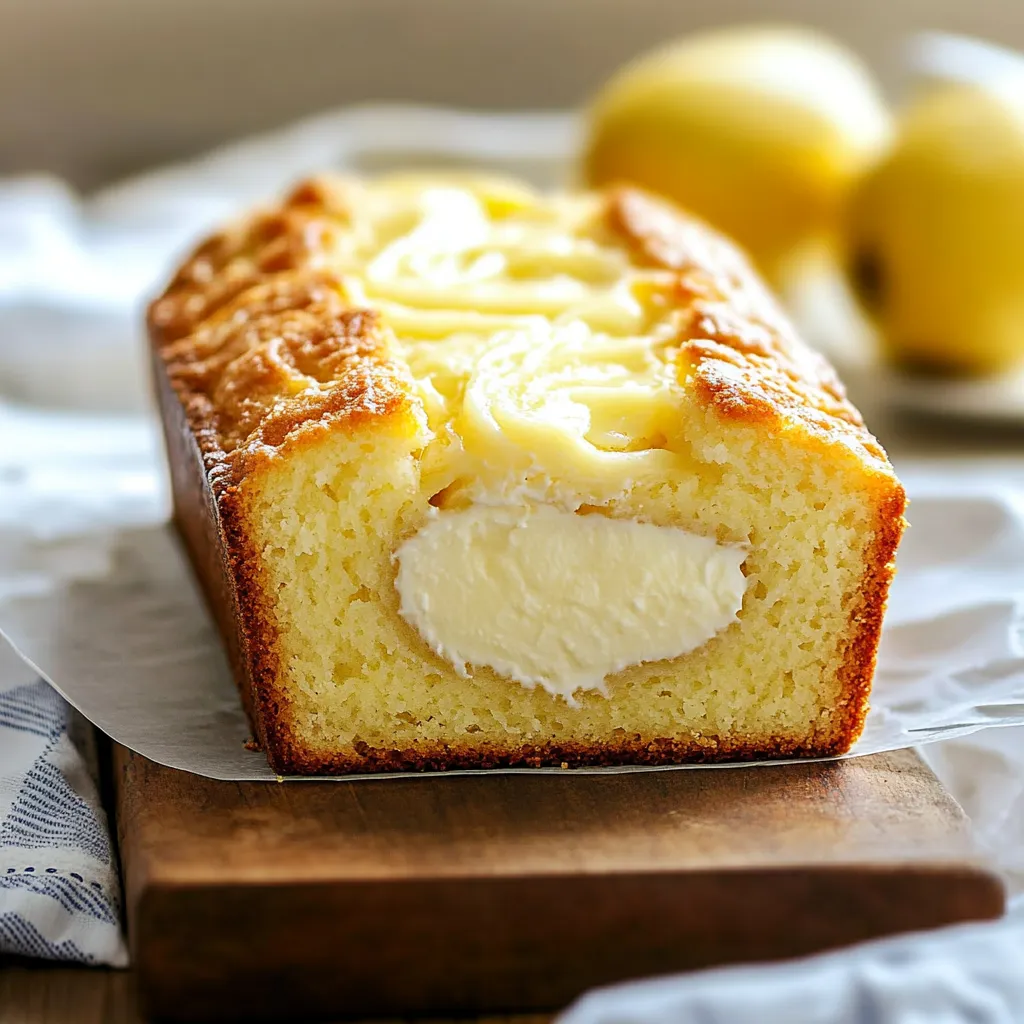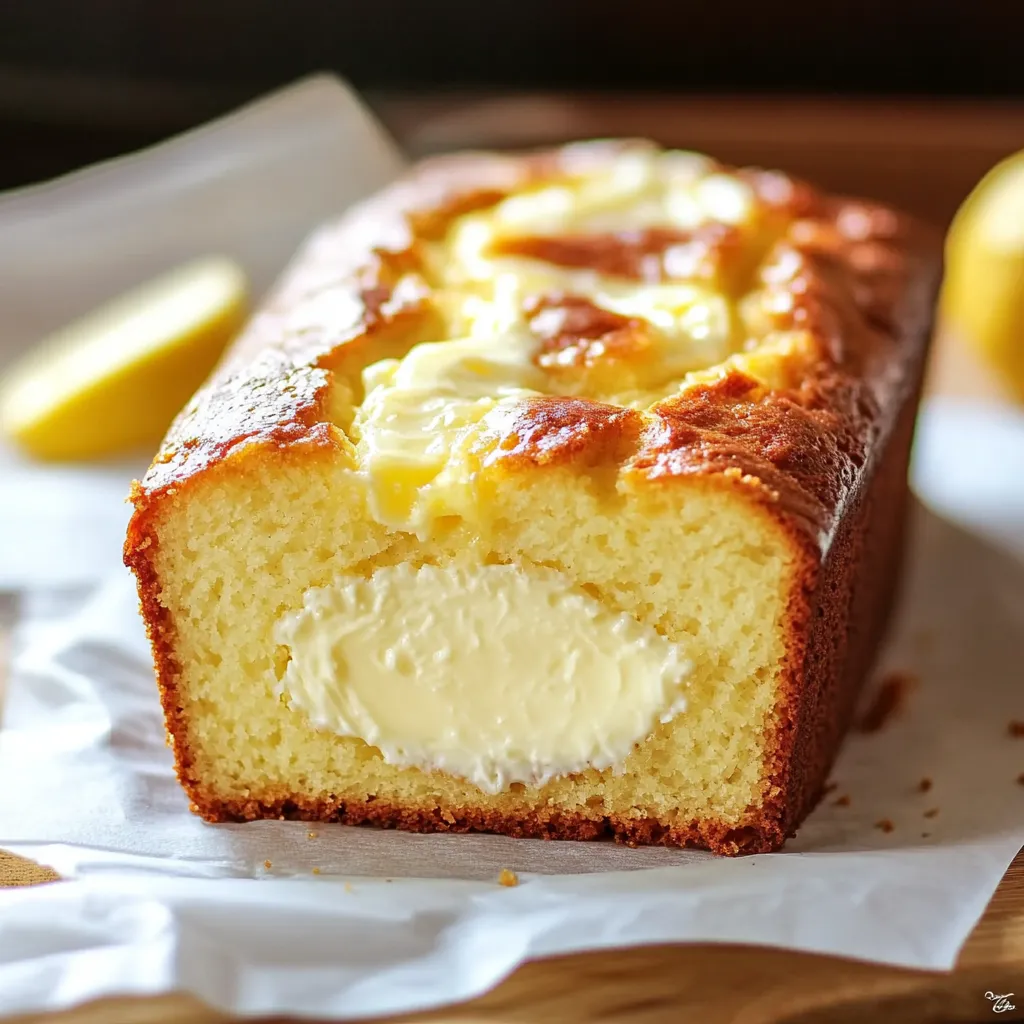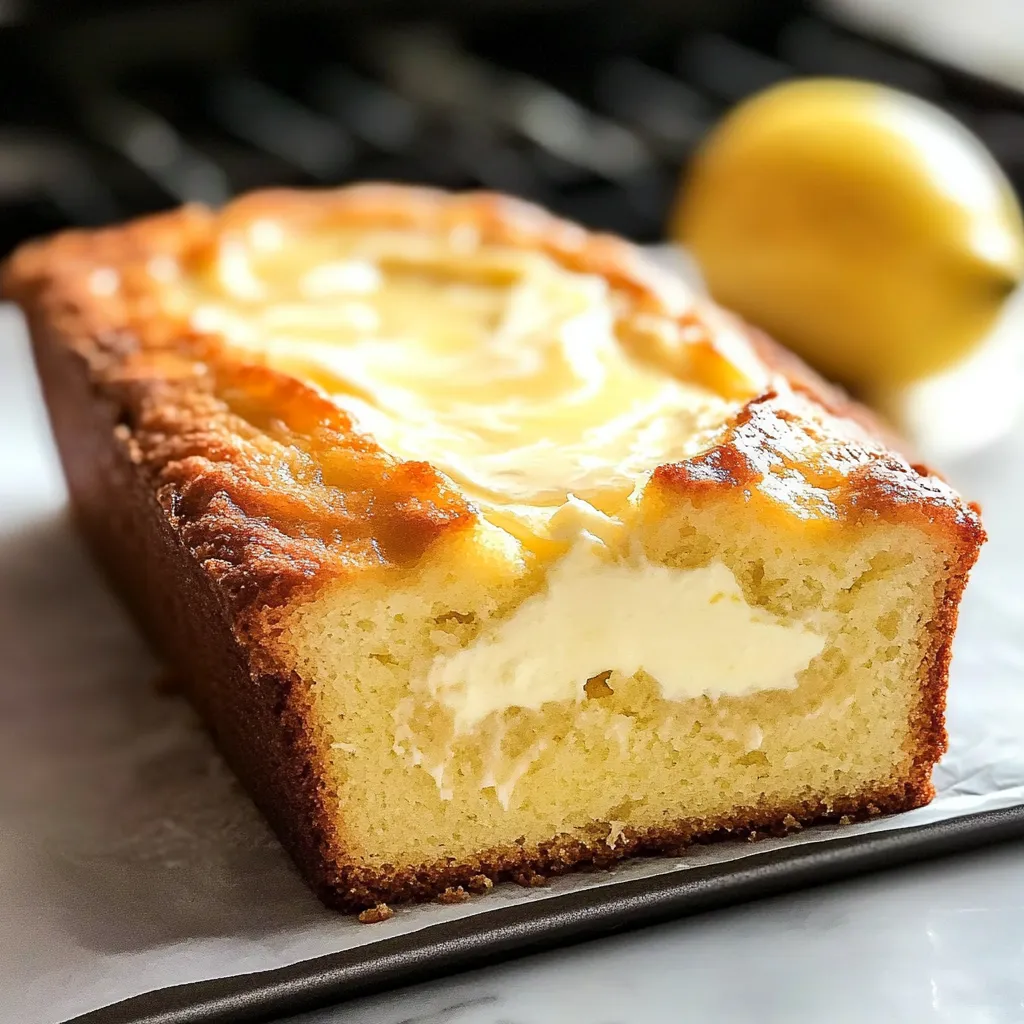 Pin it
Pin it
Lemon cream cheese bread delivers an extraordinary sensory experience that balances bright citrus notes with velvety richness in each bite. The loaf develops a golden crust while maintaining an incredibly moist interior that practically melts in your mouth. What makes this quick bread truly special is how the cream cheese integrates throughout the batter, creating a subtle tanginess that complements the lemon perfectly without overwhelming it. The finished bread offers distinct flavor layers that unfold as you enjoy each slice, beginning with the sweet-tart glaze, followed by the aromatic lemon-infused crumb, and finishing with the rich undertones of cream cheese. This versatile treat transitions effortlessly from breakfast companion to afternoon indulgence to elegant dessert without missing a beat.
My journey with this recipe began during a particularly drab winter when seasonal depression had thoroughly settled in. Craving sunshine in any form, I experimented with various lemon recipes until developing this particular version. The first loaf disappeared within hours as family members kept returning to the kitchen for "just one more small slice." Since then, this bread has become my signature contribution to brunches and teacher appreciation events. Several friends who claimed to dislike lemon desserts have completely changed their position after trying this bread, which balances the citrus so perfectly with the cream cheese.
Bread Essentials
- 2 cups all-purpose flour: Provides the foundation for proper structure; measure carefully using the spoon-and-level method for accuracy.
- ¾ cup granulated sugar: Sweetens while helping to create tenderness; superfine sugar incorporates more easily if available.
- 1½ teaspoons baking powder: Creates the perfect rise without compromising the dense, moist texture; check expiration date for best results.
- ½ teaspoon salt: Enhances all flavors while balancing sweetness; fine sea salt distributes most evenly.
- ½ cup unsalted butter, melted: Contributes rich flavor and moisture; European butter with higher fat content creates exceptional results.
- 8 ounces cream cheese, softened: Delivers the signature velvety texture and subtle tang; full-fat version produces best results.
- 3 large eggs: Provide structure and richness; bring to room temperature for optimal incorporation.
- 3 tablespoons fresh lemon juice: Supplies bright acidity that defines this bread; always use fresh rather than bottled for superior flavor.
- 2 tablespoons lemon zest: Contributes concentrated citrus oils that permeate the bread; organic lemons work best as they're unwaxed.
- 1 teaspoon pure vanilla extract: Rounds out the flavor profile with subtle warmth; use real extract rather than imitation for best results.
Lemon Glaze
- 1 cup powdered sugar: Creates the sweet base for your glaze; sift before using to remove any lumps.
- 2-3 tablespoons fresh lemon juice: Thins the glaze while adding additional tangy brightness; adjust amount for desired consistency.
- ½ teaspoon lemon zest: Provides visual appeal and concentrated flavor bursts; reserve from lemons used in the bread.
 Pin it
Pin it
Baking Instructions
- Prepare Your Space:
- Position oven rack to the middle position and preheat to exactly 350°F. Thoroughly prepare a 9×5-inch loaf pan by either greasing all surfaces or lining with parchment paper with overhanging edges to create handles for easy removal. Gather and measure all ingredients before beginning, ensuring butter has cooled slightly after melting and cream cheese has softened completely.
- Create The Foundation:
- In a medium bowl, whisk together flour, sugar, baking powder, and salt until thoroughly combined and uniform in appearance. This even distribution prevents bitter baking powder pockets in your finished bread. Whisking incorporates air and breaks up any flour clumps that could create dry spots.
- Build The Wet Mixture:
- In a large bowl, beat softened cream cheese using an electric mixer until completely smooth and free of any lumps. Add melted butter and continue beating until the mixture becomes remarkably creamy and uniform. Incorporate eggs individually, allowing each to blend completely before adding the next. Stir in lemon juice, zest, and vanilla until fully integrated, creating a smooth, fragrant base.
- Combine With Care:
- Gradually add dry ingredients to your wet mixture in three additions, folding gently with a spatula until just combined. Stop mixing the moment no dry flour remains visible. Overmixing activates gluten and creates a tough rather than tender crumb. The batter should appear thick but pourable, with tiny flecks of lemon zest distributed throughout.
- Transfer And Bake:
- Pour batter into your prepared pan, using a spatula to guide it into corners and create a relatively smooth top surface. Tap the filled pan gently against the counter several times to release any trapped air bubbles. Place in preheated oven and bake for 55-60 minutes until golden brown and a wooden pick inserted in the center emerges with just a few moist crumbs.
- Cool With Patience:
- Allow bread to rest in the pan for precisely 10 minutes after removing from the oven. This cooling period allows the structure to set while still warm enough to release easily. Transfer to a wire cooling rack and allow to cool completely before glazing, approximately 1-2 hours depending on room temperature.
- Finish With Glaze:
- Once bread has completely cooled, whisk together powdered sugar and lemon juice in a small bowl until silky smooth, adjusting consistency as needed. The perfect glaze should coat the back of a spoon while still flowing slowly. Drizzle generously over the top of your bread, allowing it to cascade attractively down the sides. Sprinkle with reserved lemon zest for visual appeal and let set for 15 minutes before slicing.
Storage Solutions
Preserve optimal texture and flavor through proper storage techniques. Once completely cooled, wrap the unglazed bread tightly in plastic wrap followed by aluminum foil if you plan to glaze later. This double protection prevents the bread from drying out while sealing in the delicate citrus aroma.
 Pin it
Pin it
Serving Inspirations
Elevate this bread beyond simple slices with creative serving approaches. Transform into an elegant dessert by toasting slices lightly and topping with macerated berries and a dollop of lightly whipped cream. The gentle heating reactivates the aromatic oils in the lemon zest while creating textural contrast between the toasted exterior and soft interior.
Frequently Asked Questions
- → Can I use bottled lemon juice instead of fresh?
- While bottled lemon juice will work in a pinch for this Lemon Cream Cheese Bread, fresh lemon juice provides a significantly brighter, more authentic flavor. Bottled juice often has a slightly bitter aftertaste and lacks the aromatic compounds found in fresh lemons. The recipe also calls for lemon zest, which contains essential oils that give a true lemon flavor, and you can only get that from fresh lemons. If you must use bottled juice, consider adding an extra teaspoon of zest to compensate for the flavor difference.
- → Why did my cream cheese swirl sink to the bottom of the bread?
- If your cream cheese swirl sank in your Lemon Cream Cheese Bread, it was likely too thin in consistency. To prevent sinking, make sure your cream cheese is just softened, not warm or melty. Beat the cream cheese mixture just until smooth without incorporating too much air. The egg yolk helps stabilize the mixture, so don't skip it. Another tip is to make sure your bread batter has the right consistency - it should be thick enough to hold up the cream cheese mixture. If your batter seems too thin, fold in an extra tablespoon of flour before assembling the loaf.
- → How do I know when my bread is done baking?
- Testing doneness in Lemon Cream Cheese Bread can be tricky because of the cream cheese swirl. A toothpick inserted into the center should come out clean or with a few moist crumbs (not wet batter) when the bread is done. However, if you hit a pocket of cream cheese, it might look underdone even when the bread is fully baked. For a more reliable test, look for these signs: the bread should pull away slightly from the sides of the pan, the top should be golden brown, and the loaf should feel springy when lightly pressed in the center. If in doubt, it's better to bake an extra 5 minutes (covering with foil if the top is getting too brown) than to have an underbaked center.
- → Can I freeze this lemon bread?
- Yes, Lemon Cream Cheese Bread freezes beautifully! Allow the loaf to cool completely, then wrap it tightly in plastic wrap followed by a layer of aluminum foil or place it in a freezer-safe zip-top bag with the air pressed out. It will keep well for up to 3 months. You can freeze the entire loaf or pre-slice it before freezing for individual portions. To thaw, leave the wrapped bread at room temperature for several hours or overnight in the refrigerator. For a quick breakfast, you can even toast frozen slices directly from the freezer. The cream cheese swirl might change slightly in texture after freezing but will still be delicious.
- → Can I make this bread gluten-free?
- You can adapt this Lemon Cream Cheese Bread to be gluten-free by substituting the all-purpose flour with a good quality gluten-free 1-to-1 baking flour blend that contains xanthan gum. Without this binding agent, the bread may crumble. Brands like Bob's Red Mill, Cup4Cup, or King Arthur Measure for Measure work well. The texture might be slightly different from the original - possibly a bit more dense or crumbly - but still delicious. All other ingredients in the recipe (butter, eggs, cream cheese, etc.) are naturally gluten-free, so no other substitutions are needed. For best results, let the batter rest for 30 minutes before baking to allow the flours to hydrate properly.
